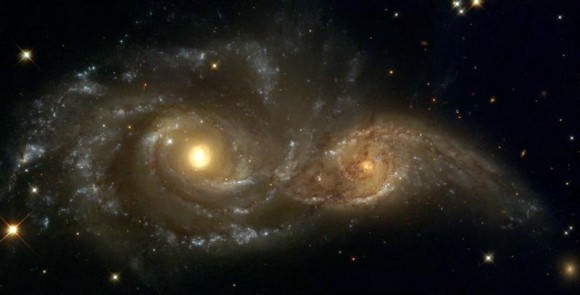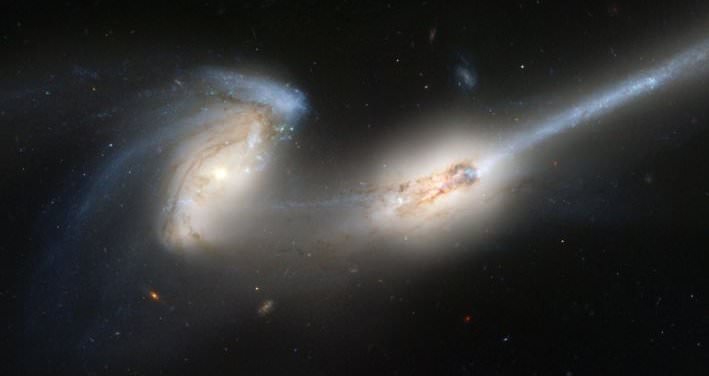Here’s your chance to play online slot machines without risking your life savings. Plus it’s an opportunity to contribute to a citizen science project that is sure to revolutionize our understanding of galaxy mergers. Galaxy Zoo’s newest project asks for help in looking at colliding galaxies, and uses a tool akin to a cosmic slot machine to compare images of galactic pile-ups with millions of simulated mergers.
“The analogy I’ve been using is that it is like driving past a car crash,” said Galaxy Zoo team member Chris Lintott from Oxford University. “You get a snapshot of the action, but there are two things you want to know: what caused the crash (or what did things look like before it all went wrong), and you want to know what the outcome is going to be. We’re doing the same thing. We want to know what the galaxies looked like before the mergers started disrupting them, and we want to know how they are going to end up. Just like our other Galaxy Zoo projects, humans are much better at doing this than computers, and lots of humans are even better.”
The Galaxy Zoo mergers project goes live on November 24 at http://mergers.galaxyzoo.org
“This is another classic Galaxy Zoo problem,” Lintott told Universe Today. “We found 3,000 galaxy mergers from Galaxy Zoo 1, and we don’t have a good understanding of the processes that take place during and after the collisions. This new project will help us work that out.”
On the Galaxy Zoo Mergers page, there will be a real image of a galactic merger in the center and with eight randomly selected merger simulations filling the other eight ‘slots’ around it. Visitors to the site pick which animation best demonstrates what is happening in that collision. But if they don’t see a good simulation, they can “spin the wheel again,” Lintott said, until a good depiction of the merger shows up.

“By randomly cycling through the millions of simulated possibilities and selecting only the very best matches the users are helping to build up a profile of what kind of factors are necessary to create the galaxies we see in the Universe around us — and, hopefully, having fun too,” Lintott said.
There’s also the “enhance” option, where you can take control. “Once you have picked a simulation, you can take control of it directly, and change the parameters by hand such as the size, mass, the speed, for example. So, if you get impatient you can take control and see if you can do a better job than the slot machine,” Lintott explained.
For some of mergers, there will be a unique solution – only one way to get the merger we see today. For others there may be many different simulations that could provide the answer.
The Mergers project is a bit different than the regular Galaxy Zoo in that there will be, initially, just one daily challenge. “We’re aiming for one a day, but obviously if everyone who reads Universe Today turns up, we’ve got an idea of how many people we need to look at each one, so then we’ll change them out quicker,” Lintott said. “The more that people do, the more galaxies they’ll get to see.”
Of course, galaxy mergers are beautiful and amazing astronomical objects to behold, so the Galaxy Zoo team is hoping this will be a popular project.
“The point of Galaxy Zoo is to try and understand how we got the mix of galaxies that we see today,” Lintott said. “One of the mysteries is trying to work out how the ellipticals formed. We know that one way to form elliptical is to smash two spirals together. There’s the famous simulation of the Milky Way and Andromeda colliding and everyone assumes it will end up as a big elliptical that has used up all its gas. But actually it’s not clear how often that happens, and it’s not clear that you always get elliptical when you smash spirals together. In fact we know that in some cases they don’t. There is a lot of debate as to how important mergers are in this process.”
Right now, 3% of galaxies are in the process of merging, so, Lintott said, if most big galaxies undergo a merger every million years or so, this is clearly an important process.
“But we don’t understand what affects it has, and that’s what we hope to realize in this project.”
And Lintott admitted this newest Galaxy Zoo project is supposed to be fun and addictive. “Some people will love it, and some people will probably prefer the regular Galaxy Zoo. But it’s nice to have a range of scientific tasks that we have to work through.”
For more information:
Galaxy Zoo Mergers
Galaxy Zoo


Cool. I’ll have a crack…